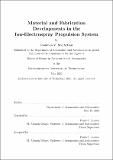| dc.contributor.advisor | Paulo C. Lozano. | en_US |
| dc.contributor.author | MacArthur, Jonathan V. | en_US |
| dc.contributor.other | Massachusetts Institute of Technology. Department of Aeronautics and Astronautics. | en_US |
| dc.date.accessioned | 2020-09-03T17:45:41Z | |
| dc.date.available | 2020-09-03T17:45:41Z | |
| dc.date.copyright | 2020 | en_US |
| dc.date.issued | 2020 | en_US |
| dc.identifier.uri | https://hdl.handle.net/1721.1/127075 | |
| dc.description | Thesis: S.M., Massachusetts Institute of Technology, Department of Aeronautics and Astronautics, May, 2020 | en_US |
| dc.description | Cataloged from the official PDF of thesis. | en_US |
| dc.description | Includes bibliographical references (pages 95-96). | en_US |
| dc.description.abstract | In this thesis, new materials, microfluidic control devices, and fabrication techniques were developed in support of the ion electrospray propulsion system (iEPS) developed by MIT's Space Propulsion Lab. MEMS fabrication techniques are reworked to increase yield reliability of the thruster frames. The focus of this work is on propellant management, increasing thrust density, system robustness, and reducing cost of thruster production. Altered fabrication process steps have led to reliable 100 percent yields. A large focus of improving iEPS thrusters is tied to preventing premature wetting of the thruster emitter with propellant and adding the ability to modulate flow on command. The development of a flow-regulating solid-state valve using similar fabrication methods facilitates this. Initial designs and fabrication trials are explored alongside the underlying physics of operation. Additionally, a new monodisperse, sintered porous silica ceramic was developed for use in emitter substrates. The highly-modifiable, photocurable ceramic resin used to cast the emitter substrates is a strong contender to replace the state-of-the-art borosilicate glass chips. An experimental new material emitter was tested to gain a voltage-current relation as well as time-of-flight spectroscopy. This new silica ceramic demonstrated promising tip geometry after laser ablation, good wetting characteristics, and excellent current emission in the purely ionic thruster operation mode. | en_US |
| dc.description.statementofresponsibility | by Jonathan V. MacArthur. | en_US |
| dc.format.extent | 101 pages | en_US |
| dc.language.iso | eng | en_US |
| dc.publisher | Massachusetts Institute of Technology | en_US |
| dc.rights | MIT theses may be protected by copyright. Please reuse MIT thesis content according to the MIT Libraries Permissions Policy, which is available through the URL provided. | en_US |
| dc.rights.uri | http://dspace.mit.edu/handle/1721.1/7582 | en_US |
| dc.subject | Aeronautics and Astronautics. | en_US |
| dc.title | Material and fabrication developments in the ion-electrospray propulsion system | en_US |
| dc.type | Thesis | en_US |
| dc.description.degree | S.M. | en_US |
| dc.contributor.department | Massachusetts Institute of Technology. Department of Aeronautics and Astronautics | en_US |
| dc.identifier.oclc | 1191819453 | en_US |
| dc.description.collection | S.M. Massachusetts Institute of Technology, Department of Aeronautics and Astronautics | en_US |
| dspace.imported | 2020-09-03T17:45:41Z | en_US |
| mit.thesis.degree | Master | en_US |
| mit.thesis.department | Aero | en_US |
